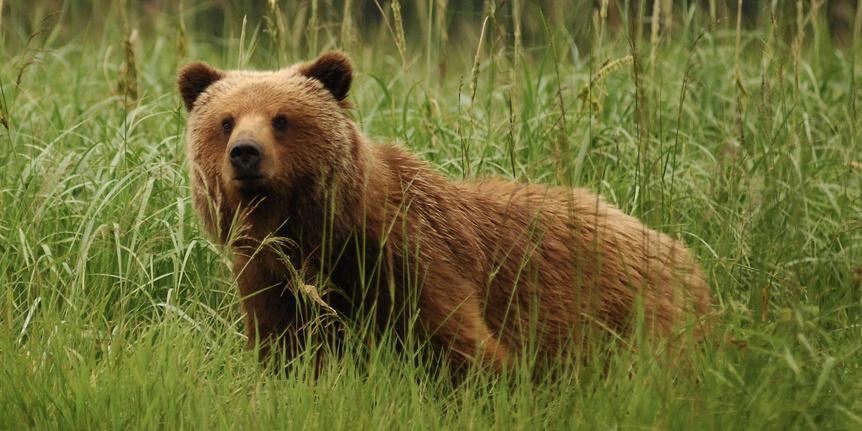(engine buzzes) - Most of the poaching is done opportunistically from roads, you know, so a tiger that isn't afraid of cars, and a lot of animals aren't, it has a good chance of getting poached.
Whereas Danny, he ran up the bank, came around here and then ducked down behind this tree.
So you can see where his front feet were here and his tail stretches around right back here.
So probably a car came, he hopped up, he ducked down.
- [Narrator] It's 1996, and we're making a film about Siberian tigers.
- [Assistant] Sound roll 16, Ccmera roll 41, and take it, mark it.
- [Narrator] In a remote forest of the Russian far East.
- [Reporter] Dale, what are your personal feelings about the future of this region and the future of the tiger?
- I'm really optimistic.
- [Narrator] I mean, that's the million dollar question, isn't it?
What does the future hold for one of the largest cats on earth?
- My name is Dale Miquelle.
- [Narrator] Well, the future is now.
That was nearly 25 years ago, and we do have some answers.
- I'm director of the WCS Russia program and also coordinator of the WCS tiger program.
- [Narrator] But I wanna stick with the origin story for now.
I wanna take you back in time.
The beginning of Siberian tiger conservation in the Russian far East.
- [Dale] Before we even got there, tiger story can lead up to the dissolution of the Soviet Union.
- [Reporter] For a moment it seemed, the situation was out of control.
- And at that time, we thought the project was over because things were falling apart in Russia.
- [Reporter] This did perhaps mark the beginning of the end.
- [Narrator] By the end of 1991, the Soviet Union had collapsed.
- There was economic chaos politically.
It wasn't clear what was going to happen.
Yet, our contacts said, come on over.
Everything's fine.
We're ready to go to work.
And so we came not really knowing what to expect.
On January 7th of 1992, we flew to the village of Terney where unbeknownst to me, I'd spend the next 25 years of my life.
- [Narrator] The town of Terney is a remote village at the edge of the Sikhote-Alin Biosphere Reserve.
The region is home to 95% of the remaining wild Siberian tigers.
- [Dale] I thought we'd come to the ends of the earth, to be honest.
It just seemed like we're coming into a place that time had forgotten.
- Things were pretty bleak in the Russian far East at that time, you know.
- [Narrator] This is John Goodrich, chief scientist and tiger program director at Panthera.
- And people were really struggling.
I remember going into the stores for the first time in Terney, there was nothing.
You know, you could go to a loaf of bread and maybe a can of some really awful canned meat, but that was about it.
- The village looked foreign to me, but the forest felt like something I knew.
It was amazing how similar it was to being in the green mountains of Vermont or the white mountains of New Hampshire.
Except I had to keep reminding myself that this isn't New Hampshire.
There's tigers walking around out here.
Russians had done a great job of going out in the wintertime and following tracks on the snow.
But when the snow melted, the tracks were gone and nobody had any idea what happens for the rest of the year.
- [Narrator] This would be the first ever joint Russian and American conservation effort for Siberian tigers.
And it couldn't have come at a more critical time.
Tiger populations were dwindling.
Less than 400 remained in the wild.
- So when we came to Russia, we had a pretty simplistic understanding of what we wanted to do, but basically we wanted to understand the ecology of the Siberian tiger.
As far as we knew, there was very little known, and we understood at that time, as we do now that to save a species, you have to understand what it needs.
A kill up there about 25 meters from the road.
- [Assistant] Jesus.
- Okay, well, radio telemetry gives us a tremendous amount of information.
How far are they move each day, find kills and determine their food habits, social relationships, and determine how often male and female tigers are together.
She is in the same place.
- [Narrator] At the time, radio telemetry was the best available technology, but battery life was limited.
And every four years, the collars on their study animals would need to be replaced.
- [Dale] It's really important to get these animals radio collared because tigers are very secretive.
You can't go out and sit down and watch them.
With tigers, you can't do that.
You almost never see them.
- [Linda] Our biggest concern is that the animal is down.
Soon as it looks like it's down, we got to get on the ground as quickly as possible.
At that point, when the animals on the ground, every minute is crucial.
- So we were really trying to collect just baseline data on tiger ecology, on what they needed, what the threats to tigers were in order to build conservation plans for tigers.
There, kiddo.
It was both dangerous and exhilarating because there are a few lots.
And so it allowed us to do things that today we probably couldn't do.
And it also provided opportunities for conservation that today would be very hard to do.
- [Narrator] Over the next 15 years, This dedicated team would gain a much better understanding of tiger ecology.
- She's moving, but she's starting to twitch and stuff already.
So we can get this later.
Just leave everything.
- [Narrator] But it would also discover some hard truths.
- What we learned over time is that when they died, they died at the hands of humans.
It became clear that local people, many of them had lost their jobs, and people needed a source of income, and there was no alternative except to go to the forest and try to bring something home that would have value.
Tiger parts are considered valuable as traditional Asian medicines.
And so then as now, there's a huge demand for those products.
It's one of the few things that a Russian could sell and make a lot of money quickly.
- Poaching was very closely tied to roads.
In other words, people weren't walking deep into the forest in search tigers.
They were driving the roads.
Maybe it was a log truck driver, keep a gun in the car, and if you happen to see a tiger on the road, jump out, shoot it, throw it in the truck, and off you go.
It was very opportunistic poaching, but it was having a serious impact on tiger numbers.
- [Narrator] When a tiger died at the hands of humans, it wasn't merely a scientific loss.
The loss was felt personally.
- It's a tiger.
My God.
(trappers chatting) - [Narrator] I was there when Linda Kerley discovered that one of her tigers had been hit by a truck.
(trappers chatting) - All of our radio collar tigers are like, are individuals to us.
And so when something happens to one of them, it becomes a very personal thing, a personal loss.
The tracks start here.
It's like they hit her, and they drug her under the back tires all the way to here.
The fact that the animal died a senseless death because somebody was driving too fast on the road does make me angry.
- This is the only road through the reserve.
And it goes right through the middle of one of the most productive tiger home ranges on the reserve, but because of this road, every single tiger that has been born in this area for at least the last eight years has died as a result of either being hit by cars or from being shot by poachers from the road.
About 70% of radio collar tigers were killed by poachers in the 15 years or so that I worked there.
- [Narrator] But in the midst of these tragedies, something unexpected was beginning to happen.
The project's tigers were becoming famous.
- In February of 1992, we were able to set snares and capture not the tigris but her cub.
Olga, became her name.
If I was walking down the street or going to the store, people would stop and ask me about Olga.
Where she was and what she was doing.
- [Dale] Her home range bordered Terney.
So she literally walked through some of the people's backyards and literally walked through Terney.
People got to know her really well.
- [John] For the first time ever in Russia, tigers weren't just an abstract beast out in the forest.
This was an individual that people knew about and were concerned about.
- [Narrator] So let's get back to my earlier question, a question I asked nearly 25 years ago, what does the future hold for the Siberian tiger?
- So the situation in 1996 was dramatically different from what it is now.
Now there's been longterm stability.
And a lot of the regulations that are valuable for conservation are now in place.
Making sure that is a deterrence to poaching, that there's a cost that poachers get caught.
That's been really important.
(marching band music) - [Narrator] And that small seed of hope first planted in the 1990s has grown.
Today, tigers are seen as an important cultural symbol and a source of pride.
- Every year in Vladivostok, thousands of people come out on the streets on the last weekend of September to celebrate tigers.
Thousands of kids are on the main square hearing and learning about tigers and tiger conservation.
(speaks in foreign language) For the first time I think ever, people started thinking about tigers as animals that are out there and have their own personalities and characters.
- [Narrator] Tigers still face many challenges across their range from loss of habitat and poaching to climate change, but it gives me great hope knowing that those dedicated individuals I was so fortunate to meet as a young filmmaker, continue their work on tiger conservation to this day.
- [Dale] The tiger is perhaps the ultimate symbol of wildness.
It's our link to nature.
If we can't save an animal with that strong a cultural symbol, not only for Russia, but for the whole world, it comes down to asking the question of whether or not we can save ourselves.
(gentle music)













